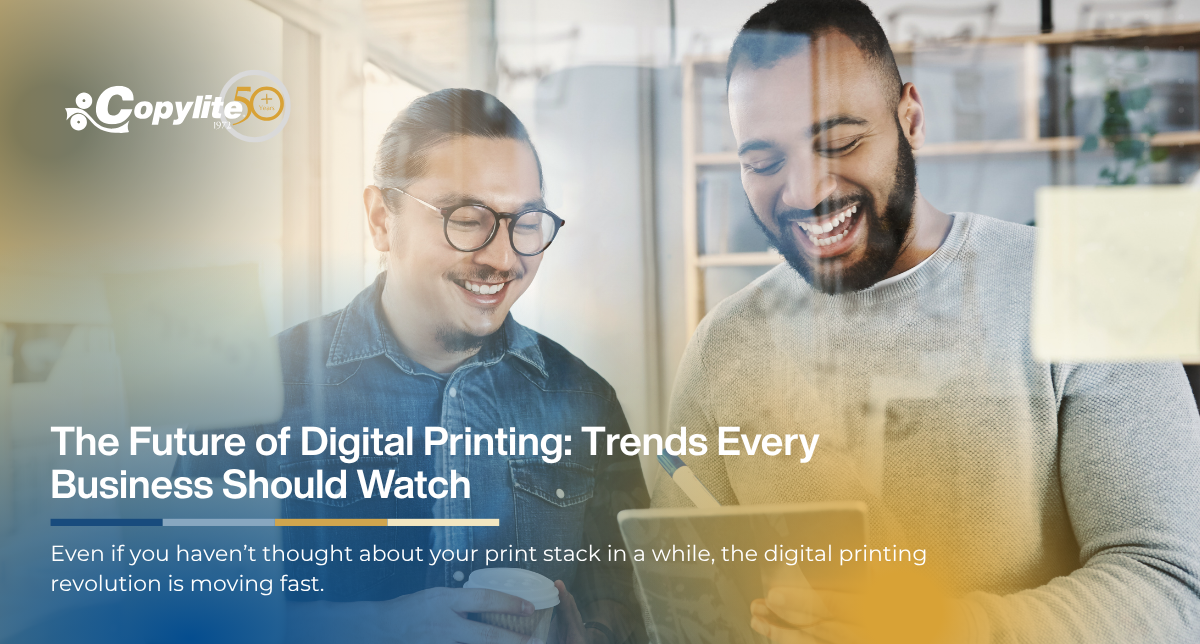Pull up a chair (or swivel in that CEO chair—no judgment), and let’s have the conversation you didn’t know you needed: what’s next for digital printing and why you, as a business leader or IT pro, should keep your eyes peeled on the horizon.
Even if you haven’t thought about your print stack in a while, the digital printing revolution is moving fast—think Formula One, not Sunday joyride. If you want to stay ahead, save money, and keep your tech sharp, now’s the time to tune in.
In this guide, we’ll explore the most impactful digital printing trends on the business landscape. You’ll get actionable insights for IT decision-makers, business owners, and yes, the big-picture keepers of the brand: you, the CEO. We’ll talk about innovation, key benefits, and hands-on tips to ensure your business doesn’t just keep up, but steps up. Ready for a rapid-fire brainstorm? Let’s dive in.
What Is Digital Printing (and Why Should You Care)?
Unlike traditional methods that rely on plates and set-up time, digital printing uses digital files (think PDFs or JPEGs) to print directly onto media. It’s on-demand, cost-effective, and flexible.
For modern businesses, digital printing means quick turnarounds, short print runs, and the magic words: customization at scale.
The Business Case for Digital Printing
If you’re a CEO, business owner, or IT specialist, digital printing matters for a few simple reasons:
- Speed: Launch marketing campaigns or branded materials in hours, not weeks.
- Cost Efficiency: Print only what you need, when you need it.
- Personalization: Tailor materials for individual clients or teams.
- Sustainability: Reduce waste and overproduction.
With those table stakes set, let’s look at where digital printing is heading—and how you can leverage new tech to future-proof your business.
1. The Rise of Web-to-Print Solutions
One of the most disruptive trends in digital printing is the expanding world of web-to-print. These solutions allow employees, clients, or partners to order marketing collateral, manuals, or branded swag directly from an online portal.
Why It Matters
- Streamlined Workflow: No more trading PDFs over email and hoping for the best.
- Brand Consistency: Lock in corporate templates so your branding doesn’t get a DIY makeover by accident.
- Analytics and Approval: Track orders, set spending limits, and maintain oversight from anywhere.
Action Steps
- Audit your current print workflows. How manual or email-heavy are they?
- Explore web-to-print platforms that connect directly with your brand assets and approval chains.
- Train teams to self-serve routine items, freeing up marketing and IT staff.
2. Personalization and Variable Data Printing (VDP)
Digital printing tech is making one-to-one marketing more powerful than ever. With VDP, you can change text, images, or design elements from one printed piece to the next—automatically.
Who’s Crushing It?
- Financial services: Sending custom statements, prefilled offers, and policy updates.
- Higher ed: Personalized acceptance packages (with the student’s name—hello, brag moment!).
- Retail: Targeted coupons and direct mail offers.
Action Steps
- Work with your marketing and IT leads to identify opportunities for custom outreach.
- Leverage your CRM data to power personalized print campaigns.
- Test small, targeted runs to measure response rates before scaling up.
3. Sustainability and Eco-Friendly Materials
Green is more than a buzzword—it’s a core demand from customers, employees, and stakeholders. Digital presses now support a range of recycled papers, soy-based inks, and environmentally friendly packaging.
Key Trends
- FSC (Forest Stewardship Council) certified papers
- Carbon-neutral production processes
- Printing on demand to reduce waste
Action Steps
- Request sustainability reports from your print vendors.
- Implement internal policies encouraging double-sided and short-run digital jobs.
- Highlight green printing initiatives in your marketing—it’s a differentiator!
4. Integration with Cloud and IoT
Modern digital printers are smarter than ever. We’re seeing rapid adoption of cloud-based print management systems and Internet of Things (IoT) sensors. This means more convenience, data, and security.
What Does This Look Like?
- Employees send files to the printer from anywhere, even their mobile device.
- Printers self-diagnose maintenance needs, reducing downtime.
- Enhanced document security: PDFs disappear after printing; jobs are encrypted in transit.
Action Steps
- Evaluate your fleet—are your printers cloud-ready and up to date?
- Upgrade to IoT-enabled devices that offer predictive maintenance and self-updates.
- Integrate print management with single sign-on for an easy, secure user experience.
5. Automation and Artificial Intelligence (AI)
Let’s face it, AI is everywhere—and yes, it’s changing digital printing too. Smart systems now automate file preparation, error checking, color calibration, and even finishing options.
Benefits for Business
- Save IT time with auto-correct tools.
- Speed up production with workflow automation.
- Use AI-powered analytics to spot bottlenecks and recommend improvements.
Action Steps
- Book a demo with your print provider to see what new automation features are available.
- Review quarterly print reports—are there recurring issues AI could resolve?
- Set up self-healing workflows that flag, fix, or reroute jobs automatically.
6. New Frontiers: 3D Printing and Hybrid Models
Digital printing isn’t just for paper anymore. 3D printing is opening doors for on-demand prototypes, replacement parts, and even custom-printed tools. Hybrid print models combine traditional techniques with digital wizardry for unique finishes.
Hot Areas Right Now
- Manufacturing: Print parts or jigs on-site.
- Retail: Custom promotional swag and displays.
- Healthcare: Print patient models or specialized tools.
Action Steps
- Investigate whether your business can benefit from 3D printed solutions.
- Attend an industry expo or connect with vendors offering hybrid printing.
- Chat with your R&D team about how rapid prototyping could shorten project timelines.
7. Mobile Printing and Fast Turnarounds
In a mobile-first world, nobody wants to be chained to their desktop (except maybe your cat, and that’s just for naps). Modern digital printers enable printing directly from smartphones or tablets.
Why You’ll Love It
- Employees can approve, print, and pick up materials in minutes—no IT ticket required.
- Great for distributed teams or remote offices.
Action Steps
- Enable mobile print options on your Wi-Fi network.
- Update BYOD (Bring Your Own Device) policies to support secure mobile printing.
- Offer quick-start guides (with screenshots!) to help employees get up to speed.
8. Data-Driven Insights and Print Analytics
You can’t improve what you can’t measure. Today’s digital printing platforms come with built-in analytics to monitor usage, costs, and workflow efficiency.
What to Track
- Volume by department or project
- Cost-per-page vs. job complexity
- Machine uptime and issue frequency
Action Steps
- Designate a print analytics lead (hint: probably someone who loves spreadsheets).
- Review reports monthly to spot savings or efficiency opportunities.
- Use analytics to right-size your print fleet and avoid equipment bloat.
How to Future-Proof Your Printing Strategy
Feeling a little overwhelmed? Don’t worry—here’s a quick roadmap to set you up for success with digital printing, no matter your business size or industry.
Step 1: Audit Your Current Print Setup
- List your printers, software, print jobs, and vendors.
- Evaluate cost, speed, and pain points.
Step 2: Identify Low-Hanging Fruit
- Could mobile printing improve employee flexibility?
- Is personalization an untapped marketing goldmine?
- Are you still using analog workflows that digital could replace?
Step 3: Build Your Tech Stack
- Select cloud-based, IoT-ready devices that support automation.
- Ensure everything integrates with your existing IT infrastructure.
Step 4: Empower Your People
- Offer training on new digital printing workflows.
- Set up a feedback loop for continuous improvement.
Step 5: Monitor and Optimize
- Use print analytics to refine your approach quarterly.
- Celebrate quick wins—fewer IT tickets, faster project delivery, better sustainability stats.
The Competitive Edge: Printing as a Strategic Asset
Let’s get real: in a rapidly evolving business climate, print is often overlooked—but it’s still the unsung hero behind branding, communications, and operations. Adopting agile digital printing isn’t just about the equipment; it’s about giving your company the flexibility to adapt, respond, and lead.
Key Takeaways to Remember:
- Digital printing is smarter, faster, and more adaptable than ever.
- Emerging trends in personalization, automation, and sustainability are reshaping the business landscape.
- The right print strategy supports branding, saves money, minimizes waste, and unlocks innovation.
Future Trends on the Radar
To wrap up, here’s a quick peek at the digital printing trends making headlines (and soon, your balance sheets):
- Artificial Intelligence: Proactively solves issues before anyone’s coffee gets cold.
- Fully Automated Print Workflows: Speed without errors.
- Hyper-Personalization: Names, images, even QR codes—unique for every customer.
- Seamless Mobile Integration: Print what you need, when and where you want.
Final Thoughts: Don’t Wait for the Next Big Thing—Create It
You didn’t get where you are by waiting for the future to knock; you built the door (or at least supervised the installation). The same goes for digital printing: the leaders who embrace innovation, rethink workflows, and future-proof their strategies are the ones who’ll ride the next wave to success.
So, what’s your next move? Schedule a strategy session, start a pilot with a new print solution, or simply walk over and ask your IT team what they wish your printers could do. Sometimes, even big trends start with a simple conversation—which is exactly where we began.
The future of digital printing is here, and your business has a front-row seat.
Ready to print your way to the top?






